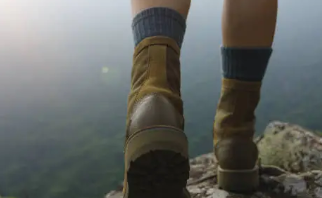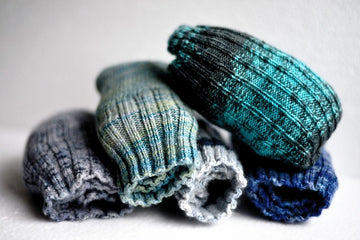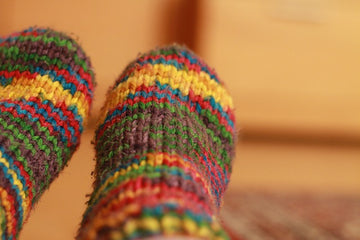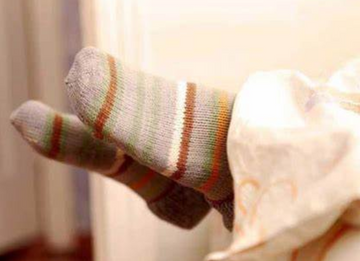
Hiking socks are more than just a fashion accessory; they play a crucial role in your overall comfort and performance on the trail. The right pair can prevent blisters, manage moisture, and provide cushioning, making your hikes more enjoyable and less painful.
Material: Choosing the Right Fabric for Your Hiking Socks
Selecting the right material for your hiking socks can make a significant difference in both comfort and performance on the trail. Each material has its own strengths, so it’s essential to choose the one that aligns with your hiking conditions and personal preferences.
Wool, particularly merino wool, is one of the most favored materials for hiking socks, and for good reason. It offers a unique combination of moisture-wicking properties and natural insulation, making it a top choice for outdoor enthusiasts.
Wool fibers can absorb up to 30% of their weight in moisture without feeling wet, keeping your feet dry even when conditions are damp.
Merino wool excels at maintaining the right temperature for your feet. It keeps them warm when the weather is cold by trapping body heat, while also allowing for ventilation to keep your feet cool in warmer climates. This makes it a versatile option for all-season hiking.
Synthetic materials like polyester, nylon, and polypropylene are popular in modern hiking socks because they are highly durable, quick-drying, and excellent at moisture management.
These synthetic fibers are specifically designed to pull moisture away from the skin and allow it to evaporate quickly, helping to keep your feet dry in wet or sweaty conditions.
Synthetic socks tend to last longer, as they are resistant to wear and tear. This makes them an excellent choice for hikers who regularly tackle challenging terrain or engage in high-intensity activities like trail running.
Unlike wool, which can take longer to dry, synthetic fibers dry quickly, making them ideal for hikers who may encounter wet conditions or need to wash and reuse their socks on the go.
Shop Hiking Socks

While cotton is known for its soft and comfortable feel, it is generally not recommended for hiking due to its tendency to retain moisture.
Cotton absorbs water and holds onto it, making your feet more prone to blisters and discomfort when wet. If your feet sweat or if you encounter rain, cotton socks will stay damp, increasing the risk of skin irritation and fungal infections.
Once wet, cotton takes a long time to dry, which can be a problem on longer hikes or in wet climates.
When to Wear Cotton:
If you’re planning a short, dry hike in warm weather, or you’re just out for a casual stroll, cotton socks can be a comfortable option. However, for longer hikes or multi-day excursions, it’s best to avoid 100% cotton socks.
Final Thoughts on Material Choices
- For colder, damp conditions, merino wool offers unbeatable warmth and moisture management.
- In hot or variable climates, a synthetic blend may be your best bet for keeping your feet dry and blister-free.
- Avoid cotton for anything more than casual hikes, as it retains moisture and can lead to discomfort.
Height: Choosing the Right Sock Length for Your Hike
The height of your hiking socks plays a crucial role in protecting your feet and lower legs, ensuring you stay comfortable and blister-free.
Crew socks are one of the most popular options for hiking, extending several inches above the ankle and typically reaching mid-calf.
These socks provide enough coverage to protect your ankles and lower legs from friction with your boots. They help prevent debris like dirt and small rocks from getting inside your footwear, reducing the risk of irritation.
Crew socks also offer excellent support, especially in combination with hiking boots. The added height protects your skin from rubbing against the top of your boots, making them an ideal choice for most hiking conditions.
Crew socks are suitable for a wide range of hikes, from day hikes to multi-day treks. They work particularly well with mid-cut or high-cut hiking boots.
Shop Crew Socks

Knee-high socks offer full coverage up to the knee, providing additional protection and support for longer hikes or rugged terrains.
These socks are great for preventing chafing and blisters, especially if you’re wearing tall hiking boots or gaiters. They cover the entire lower leg, protecting you from scratches, thorny plants, and other outdoor hazards.
By extending past the top of your hiking boots, they help prevent direct skin contact with your footwear, reducing the chances of friction and blisters.
Shop Knee-high Socks

Low-cut socks, often referred to as ankle socks or no-show socks, sit just below the ankle. While they offer the least coverage, they are a popular option for hikers who prefer a minimalist feel.
Low-cut socks are typically lightweight and provide just enough coverage to protect your feet from rubbing against your shoes. They are breathable and keep your feet cool during short hikes in warm weather.
These socks offer little protection for your ankles and lower legs, so they’re not the best option if you’re venturing into rough or brushy terrain. However, they can be suitable for shorter, casual hikes where full coverage isn’t necessary.
Low-cut socks are great for day hikes, trail running, or light outdoor activities where you don’t need much protection beyond the shoe. They work best with low-cut hiking shoes or trail running shoes, especially in dry, hot climates.
Shop Ankle Socks

By choosing the right sock height based on your footwear, terrain, and weather conditions, you can ensure your feet stay comfortable and protected throughout your hike.
Footwear: Choose a sock height that extends above your hiking shoe or boot. For example, if you’re wearing mid- or high-cut boots, crew socks or higher are ideal to prevent the sock from slipping inside the boot.
Terrain: For rugged, overgrown, or rocky terrain, higher socks like crew or knee-high options are best to protect your legs from cuts, bruises, or bug bites.
Weather: In colder conditions, knee-high socks offer more warmth and coverage, while in hotter climates, low-cut socks allow for better airflow and cooling.
Cushioning: Finding the Right Balance for Comfort and Protection
The amount of cushioning in your hiking socks plays a crucial role in providing comfort, shock absorption, and support during your hike. The right level of cushioning can make a big difference in preventing foot fatigue, blisters, and general discomfort.
Thin or lightweight hiking socks are designed for shorter hikes, trail running, or activities in hot weather. These socks offer minimal cushioning, but they are highly breathable, ensuring your feet stay cool and dry.
Thin socks tend to dry faster, making them a great option if you expect your feet to get wet or if you’re going on a short hike where you need minimal bulk.
Medium weight hiking socks offer a balanced blend of cushioning and breathability, making them the most versatile option for a variety of hiking conditions.
These socks provide moderate padding in key areas such as the heel and ball of the foot. This helps to absorb impact and reduce the risk of blisters without adding too much bulk.
These socks are ideal for moderate hiking trails, cooler weather, and a variety of terrains. They pair well with mid- to high-cut hiking boots, providing just the right amount of support and cushioning for longer hikes.
Heavyweight hiking socks provide the most cushioning, making them the best choice for long hikes, challenging terrain, and colder conditions. These socks are designed to offer maximum shock absorption and protection for your feet.
With thick padding throughout the sock, heavyweight socks excel at absorbing shock and reducing impact, which is especially important on rocky or uneven terrain. The extra cushioning helps prevent foot fatigue on long hikes.
Due to the thick padding, heavyweight socks may not be as breathable as lighter options. They are more likely to retain moisture, which can increase the risk of blisters if worn in hot weather.
Heavyweight socks are perfect for long, strenuous hikes, backpacking trips, or hiking in cold and rocky environments. They work best with heavy-duty, high-cut hiking boots that offer substantial support for rough terrain.
Choosing the Right Level of Cushioning
By understanding the different levels of cushioning and their benefits, you can choose the right socks to keep your feet comfortable, supported, and ready for any adventure!
- Hiking Distance and Duration
For shorter, faster-paced hikes or trail running, opt for thin or lightweight socks. For longer hikes or multi-day treks, medium or heavyweight socks provide the added cushioning you need to stay comfortable.
- Terrain
On rocky, uneven, or challenging terrain, heavier cushioning helps absorb shock and protect your feet from impact. On flat, smooth trails, lightweight or medium cushioning is sufficient.
- Weather Conditions
In hot climates, thin socks offer better breathability and moisture control, while heavyweight socks provide warmth and protection in cold conditions.
Are compression socks good for hiking?
Compression socks are a great part of your hiking equipment because they can really help you out. They improve blood flow, which means less swelling and tiredness in your legs during those long hikes. Plus, they give your ankles extra support, making it less likely for you to get hurt on rocky paths. These socks also help you feel more balanced and comfortable while walking. If you're going on a long hike or often feel sore in your legs, wearing compression socks can make your adventure more enjoyable and allow you to hike for longer.
Should hiking socks be tight or loose?
Hiking socks should fit snugly but not too tightly. A snug fit helps prevent blisters and keeps the socks in place, while avoiding excessive tightness ensures proper blood circulation and comfort.
Do you need to wear 2 pairs of socks when hiking?
Generally, no, you don't need to wear two pairs of socks when hiking. A single pair of high-quality hiking socks is usually sufficient to provide adequate comfort and protection.
Are bamboo hiking socks good?
Yes, bamboo hiking socks are generally considered a good choice.
Bamboo helps regulate temperature, keeping your feet warm in cold conditions and cool in hot weather.
Bamboo is excellent at absorbing and wicking away moisture, helping to keep your feet dry and comfortable.
Bamboo has natural antimicrobial properties, which can help reduce odor and bacteria growth.
Which is better for hiking polyester or nylon?
Polyester is generally considered a better choice for hiking socks than nylon.
- Moisture-wicking: Polyester is hydrophobic, meaning it repels water and dries quickly. This is crucial for hiking, as it helps keep your feet dry and comfortable.
- Durability: Polyester is generally more durable than nylon, making it a good choice for activities like hiking that can be tough on socks.
- Lightweight: Polyester is lightweight, which is important for hiking as it can help reduce foot fatigue.
While nylon can also be a good choice, especially in hot, sweaty conditions, polyester's moisture-wicking and durability properties make it a more popular option for hiking socks.
Best hiking socks to prevent blisters
Shop

Best women's hiking socks in Australia
Shop

Best hiking socks for men in Australia
Shop
Best quick drying hiking socks in Australia
Shop

Best summer hiking socks in Australia
Shop

Read More
Why Do We Wear Socks
Do You Wear Socks with Climbing Shoes
What Color Socks with Brown Shoes
What Socks to Wear with Loafers
What are Grip Socks
What Socks to Wear with Cowboy Boots
Are Wool Socks Good for Summer
What Color Socks with White Shoes







